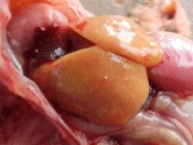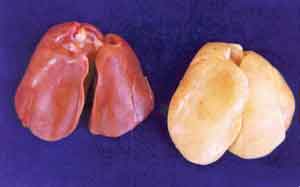Aflatoxins are one of the key challenges faced by poultry farmers as well as by Poultry Feed manufacturer in India as it leads to serious economic losses. In our country having tropical climate with hot and humid condition coupled with poor harvesting of crops during monsoon season, inadequate drying and storage facilities make feed stuff susceptible to fungal contamination resulting in greater economic losses to poultry industry through Mycotoxicosis. In addition to these there are improper management practices which are being followed at more than 60 percent poultry farms in India which further increases the risk of mycotoxins to very high level.

Mycotoxicosis is the condition associated with fungal contamination of feeds or feed ingredients. Among mycotoxins, aflatoxins are predominant and are one of the major fungal toxins which are responsible for potential problem in Poultry feeds. Aflatoxins are produced from fungi of the genus Aspergillus and major forms of aflatoxins include B1, B2, G1 and G2 with B1 being the most dangerous and common active toxin. It’s just not about Poultry but aflatoxins affect both human as well as animals. If we go into past the first time it was discovered in 1961 in Britain when more than 100,000 turkeys and many farm animals died from a mysterious disease. When cause of this disease was investigated it was found to be aflatoxins in the feed. Sources & Guidelines of Aflatoxins in Poultry diet Aflatoxins are found almost in every grains used in Poultry Industry either its Maize, Bajra or wheat. The only difference lies is in the level which mostly found very high in Maize. More than this cereal grains, soybean products, oil cakes (from groundnuts, cottonseed, sunflower, palm, and copra), and fishmeal all are having some amount of Aflatoxins. Brewers grains (a by-product from cereal-based alcoholic drinks) Corn Gluten and rice gluten all can have high levels of aflatoxins. In general, livestock in intensive systems e.g. poultry are at higher risk of dietary exposure than animals in extensive systems because in intensive system animals cannot do selective feeding or can depend on the feed which is being provided to them. Throughout world poultry birds are kept mostly in intensive systems hence aflatoxins are likely to be an increasing problem. There are strict guidelines regarding the level of Aflatoxin throughout world, especially in countries where regulation for aflatoxins in animal feeds exists, the total permissible aflatoxins levels in animal feeds range from 0 to 50 parts per billion (ppb) with an average of 20 ppb. In India as per the BIS standards the level of Aflatoxins should not be higher than 50 ppb in poultry feed but samples having levels above 50 ppb and contamination of 100 to 500 ppb are not uncommon and being reported time to time by various researchers as well as by various laboratories.
Susceptible Poultry
Depend on the sensitivity to aflatoxins livestock species are graded as below -Rabbits>Ducks>Turkeys>Chicken>Fish>Swine>Cattle>Sheep.

This grading suggests that Poultry has very high degree of susceptibility to aflatoxins as compare to other farm animals like Cattle and Fish. The effects of aflatoxins on Poultry depend on various factors like genetic (species and breed strain), physiological (age, nutrition, and stress) and environmental (climatic and farm management). Chicks at brooding stage are susceptible to even low levels of aflatoxins while and young and fast-growing birds are more affected than adults. Broiler birds are much more sensitive and susceptible than a well grown layer birds. Male birds are more susceptible than female due to higher growth rate.
Effects of aflatoxins on Poultry health and production
There are two types of toxicity happened due to aflatoxins in Poultry
1. Acute Toxicity
2. Chronic toxicity
The acute toxicity of aflatoxins in poultry varies from species to species as well governed by the age, sex and strain of the bird and its condition and generally leads to very high mortality in limited period. A variety of chronic effects has been reported for aflatoxins when fed to poultry. Chronic aflatoxicosis probably has greater economic impacts than acute disease. Numerous studies show a worsening in feed conversion ratios, a decrease in average daily gain, a decrease in body weight, lower pigmentation, less processing yield, lower egg production, effected male and female fertility, higher leg problems and lower hatchability in birds experimentally fed aflatoxins. Diets containing aflatoxins, when fed to poultry, increase the risk of attack by bacteria and viruses. The immune status of the bird is effected significantly as a result of continuous exposure of aflatoxins and organs such as Liver, Kidney, Bursa, thymus and lymph nodes are the one having maximum damage. Aflatoxins have been reported to affect the digestion of number of essential components of the poultry diet, such as coccidiostats, vitamins and amino acids. This can have a disastrous effect on poultry health and production as it make poultry birds susceptible to various production diseases such as Coccidiosis, Enteritis etc.

Clinical signs of aflatoxins toxicity include anorexia, specific visceral haemorrhage, embryo toxicity and very high susceptibility to various environmental and microbial stressors. On analyzing through histopathology the most common findings or symptoms include fatty liver, necrosis of liver and hyperplasia of bile duct. Aflatoxins have very high effects on metabolism in poultry. The activity of various enzymes required for digestion of carbohydrate, protein, fat and nucleic acid has been decreased due to aflatoxins.
Various studies have also found out that level of total protein, cholesterol and blood urea nitrogen get decreased due to effect of aflatoxins in Poultry.

Aflatoxins also have interaction with vitamin D metabolism which leads to decrease bone strength and various leg disorders. The leg disorders may be also because of extra interaction of aflatoxins with other mineral like phosphorous, Copper and Iron. Aflatoxins adversely affect cellular as well as humeral immunity. A slight lower level of aflatoxins in diet affect cellular immunity but at higher level the immunoglobulin production and response to antibodies get suppressed. Many disease outbreaks, vaccination failures and poor titre of antibodies happen because of continues exposure of aflatoxins.
Impacts of aflatoxins on meat & egg quality
A very minute level of aflatoxins and their metabolites may also carry over into the edible tissue of poultry birds. Poultry feed contaminated at the level of 3,000 ppb may result in levels of 3 ppb in poultry meat same way aflatoxins may be carried over from feed to eggs.

Aflatoxins accumulation as residue into poultry meat is much lower than transfer into ruminant milk. In case of eggs also the level of transfer is quite lower. So overall the impact of aflatoxins is more on health & production rather than on the meat or egg quality in poultry.
Control of aflatoxins in poultry feed
A practical aflatoxins control completed in two stages i.e. preventing the fungal growth as well as toxin production and secondly decontamination of existing aflatoxins in poultry feed. Several works as well strategies has been proposed by researchers such as plant breeding in such a way which can reduce the mould growth. Simultaneously improving harvesting and storage practices which can minimise contamination procedure hence reduce in aflatoxins production. For the toxin already present in the feed the most effective method for control is by addition of adsorbents which can prevent the toxin absorption from intestine. The addition of binder such as zeolite clays and aluminosilicates is very effective in reducing aflatoxins related toxicity. There are many clay base products marketed by various companies present in market having good efficacy against aflatoxins. One method of reducing moderate levels of aflatoxins contamination is by mixing good quality grain in aflatoxins contaminated feed, as this will help in reducing the overall level of aflatoxins in feed. This method is being applied by farmers at various level to control Mortality of birds as it helps in slowing down the metabolism of bird by lower density nutrition and secondly dilution of aflatoxins. Some Nutritional Modifications in feed are also very much useful for protection against aflatoxins which includes higher supplementation of vitamins, methionine and selenium. There are few chemical such as sodium bisulphite, ammonia and peroxide acids tested for detoxification but found impractical especially due to safety and palatability issue.
Conclusion
Aflatoxins can seriously reduce poultry productivity. In our country there is no poultry feed which is totally free from aflatoxins. There are instances where poultry are fed highly contaminated grains considered unfit for human consumption and are thus at risk of acute toxicosis. But in most of cases its chronic aflatoxicosis which is probably a major cause of concern as it leads to economic loss especially to poultry farmers as some time difficult to diagnose. The adverse effects of aflatoxins on poultry are too high hence there is danger which is very clear and persistent. Very careful and strong steps needed to control this problem which occurs naturally. One small step especially in developing countries like India where there is shortage of feed ingredients like corn may be to use most aflatoxins-contaminated corn in livestock feed rather than in poultry as poultry are much more susceptible. Although there are still no established levels at which we can say that aflatoxins are safe for livestock, and these large animals can tolerate aflatoxins well. Overall we should have the usage of quality ingredients in poultry diet alongside use of some mold inhibitors & binders to control the growth of mould responsible for aflatoxins. Simultaneously the farm management plays a far greater role in controlling the overall losses due to aflatoxins so it’s mandatory for the poultry farmers to follow best management practices for rearing their flocks.